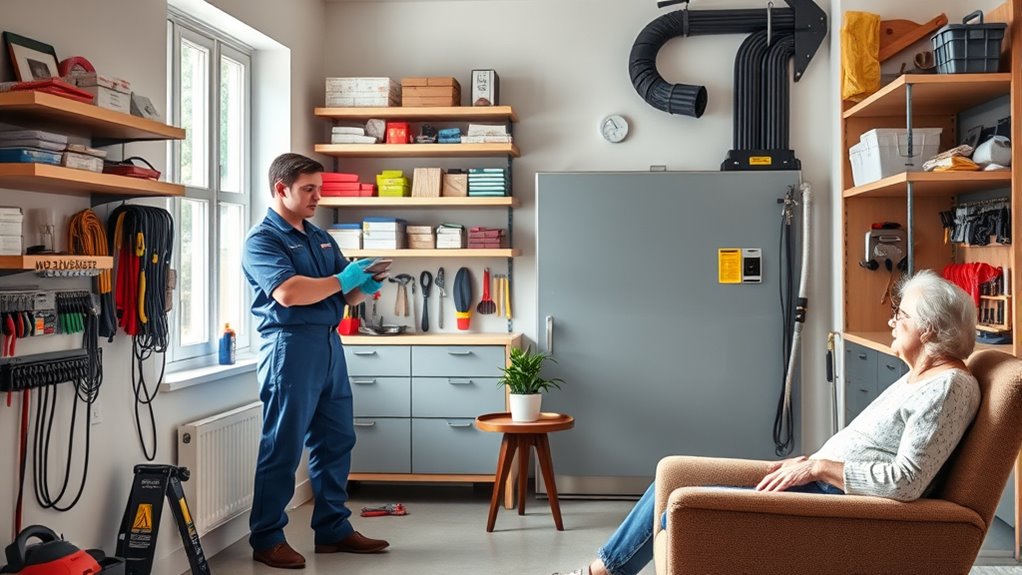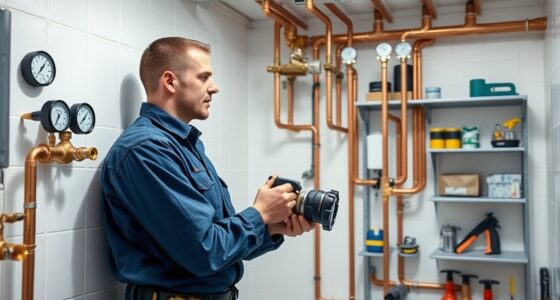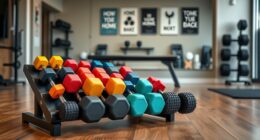To keep your senior home safe and comfortable, perform regular checks of smoke and carbon monoxide detectors, inspect walkways and stairs for hazards, and make certain lighting is sufficient. Schedule seasonal tasks like gutter cleaning, roof inspections, and landscaping. Maintain heating and cooling systems, insulate pipes, and monitor electrical systems. Establish a routine to keep everything in good shape year-round. Keep these tasks up, and you’ll create a safer, more manageable environment—more tips await to make this easier for you.
Key Takeaways
- Conduct regular safety checks on smoke alarms, CO detectors, and fire extinguishers, replacing batteries annually.
- Inspect walkways, stairs, and outdoor areas for hazards, securing loose rugs and debris to prevent falls.
- Schedule biannual exterior inspections for cracks, loose pavers, and roof damage; clean gutters and downspouts to prevent water issues.
- Maintain heating, cooling, and plumbing systems through routine inspections and servicing to ensure safety and efficiency.
- Keep outdoor spaces safe by trimming bushes, inspecting furniture, and preparing for seasonal changes to prevent hazards.
Monthly Home Safety Checks
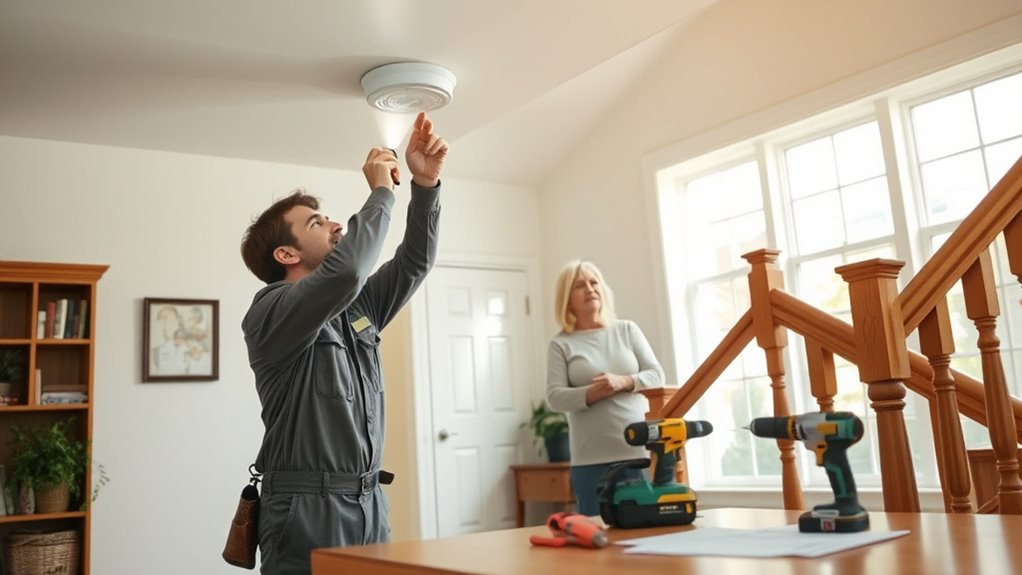
Have you checked your home safety devices this month? Regular monthly inspections of smoke alarms, carbon monoxide detectors, and fire extinguishers are essential for senior home safety. Incorporating data-driven strategies can help you track the performance and lifespan of your safety devices more effectively. Press the test buttons on your safety devices to confirm they produce a loud sound, verifying proper operation. Replace batteries in smoke and carbon monoxide detectors at least once a year, or immediately if alarms beep or malfunction. Inspect walkways, stairs, and outdoor paths for hazards like loose rugs or debris that could cause falls. Also, review and clean your fire extinguishers, checking gauges for the green zone and expiry dates. Maintaining home safety equipment ensures they are functioning properly when needed most. Regularly updating your safety protocols is vital for home safety and can prevent emergencies. Conducting preventive maintenance on safety devices helps prolong their lifespan and reliability. Staying aware of home security trends can also help you identify potential vulnerabilities and enhance your safety measures. These simple hazard prevention steps help keep your home safe, reducing risks and ensuring peace of mind for you and your loved ones.
Fall and Seasonal Exterior Maintenance
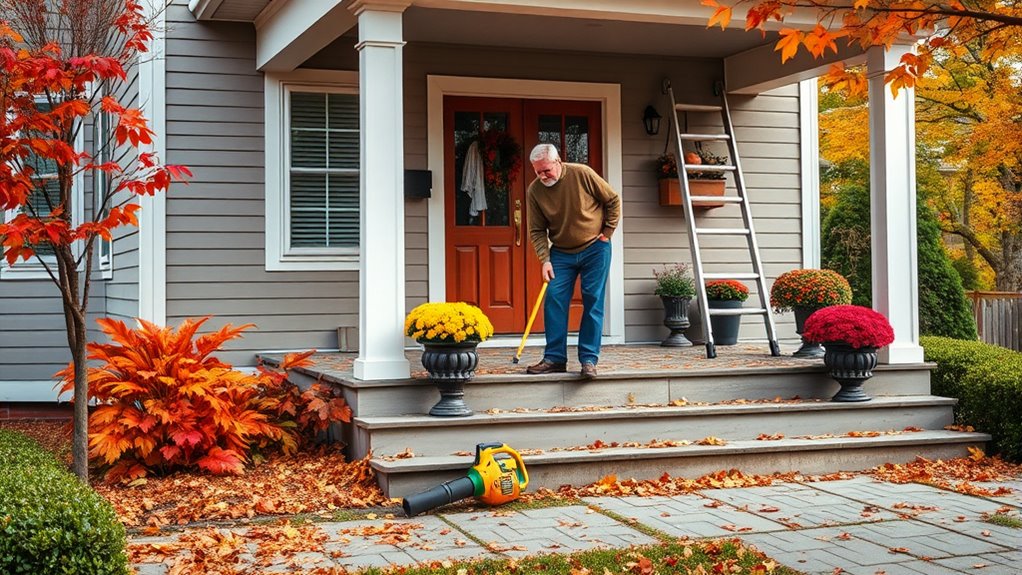
Regular fall and seasonal exterior maintenance is essential to keeping your home safe and in good condition. Performing routine exterior maintenance helps prevent water damage and water infiltration, which can lead to costly repairs.
You should inspect outdoor surfaces like walkways, stairs, and driveways biannually for cracks, uneven areas, or loose pavers, and repair them promptly. Regular inspections can also help identify potential hazards early before they become serious issues.
Clear gutters and downspouts at least twice a year, especially in fall, to ensure proper drainage.
Trim bushes, low-hanging branches, and trees near your home to keep pathways clear and reduce debris.
Additionally, seal cracks in exterior walls, windows, and doors annually to improve insulation and prevent drafts.
Regularly checking your home’s exterior for water parks and other water-related attractions can help identify potential water exposure points and prevent water-related damage. Incorporating proper drainage techniques around your home can further mitigate water issues and protect your foundation.
Ensuring proper exterior paint and sealants are maintained can also help shield your home from water penetration and environmental wear. Maintaining antique fixtures and features on the exterior can also enhance the charm and integrity of your home’s appearance. These seasonal tasks protect your home from water damage and maintain its safety and appearance year-round.
Winter Home Upkeep
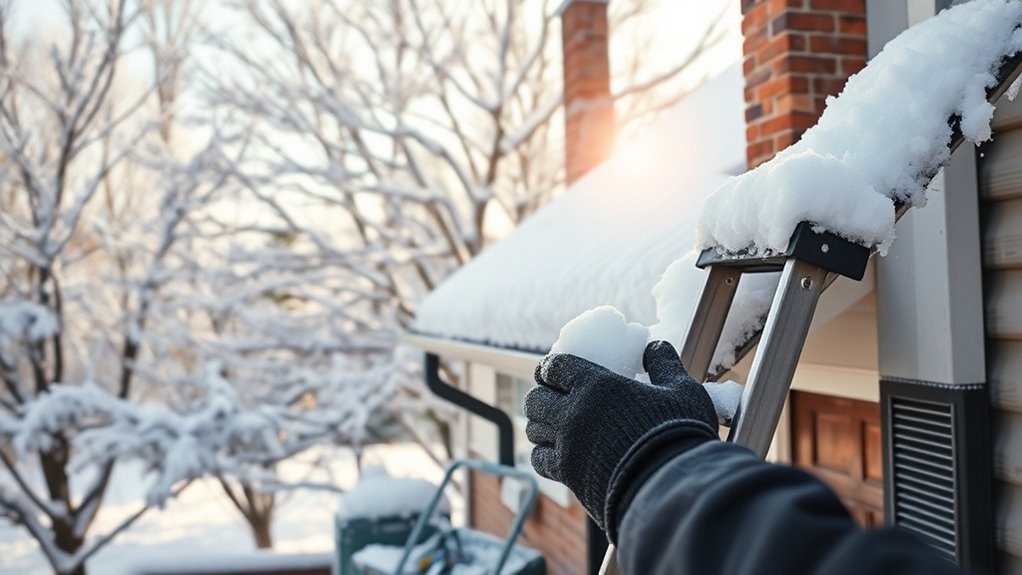
As winter approaches, it’s important to check your roof, gutters, and downspouts after storms to prevent leaks and ice dams. You should also drain outdoor faucets and insulate pipes to avoid freezing and bursting. Additionally, consider inspecting your home’s ventilation system to ensure proper airflow and reduce humidity that can cause mold or ice buildup. Proper ventilation can also help support the indoor air quality of your home during the colder months. In addition, advancements in AI chip developments can optimize your home’s heating systems for better efficiency. Regular maintenance of ventilation systems can also prevent the accumulation of moisture that promotes mold growth. Maintaining protective styling benefits for your home insulation can also contribute to energy efficiency. Finally, make certain your heating system is serviced and working efficiently to keep your home warm and safe.
Inspect Roofing and Gutters
During winter, inspecting your roof and gutters is essential to prevent costly water damage. Regular roof inspection helps identify missing, damaged, or loose shingles, reducing the risk of roof leaks. Gutter maintenance, including gutter cleaning and debris removal, ensures proper water drainage and prevents ice dams. Check for ice buildup or frost that can cause blockages or damage. Examine flashing around chimneys and vents for gaps or corrosion to prevent water intrusion. Address any roof repairs promptly to maintain your roof’s integrity.
| Task | Focus Area | Purpose |
|---|---|---|
| Roof inspection | Shingles and flashing | Detect damage, leaks, or gaps |
| Gutter cleaning | Gutters and downspouts | Ensure proper drainage |
| Debris removal | Gutters and roof | Prevent ice dams and blockages |
| Water intrusion | Flashing and seals | Avoid leaks and water damage |
Prevent Frozen Pipes
Inspecting your roof and gutters helps prevent water damage, but winter’s cold can pose additional risks to your plumbing. To prevent frozen pipes, insulate exposed pipes with foam or fiberglass sleeves, especially in unheated areas. Proper insulation is essential to maintain warm temperatures around your plumbing. Drain outdoor faucets and shut off the water supply to avoid pipes bursting, a common problem during cold weather. Keep thermostat settings at or above 55°F to maintain warmth and protect vulnerable plumbing fixtures. Open cabinet doors under sinks on exterior walls to allow warm air circulation. For extra protection, install pipe heating cables or heat tape on pipes at risk of freezing. Being aware of cold-related hazards can help you take proactive steps to protect your plumbing system. Additionally, understanding self watering plant pots can promote overall health and energy during the winter months. Recognizing the importance of dreams of deceased loved ones can offer comfort during stressful times, including the challenges of winter home maintenance. These simple steps help prevent frozen pipes, reduce the chance of costly water damage, and keep your home’s water supply flowing smoothly during winter.
Maintain Heating Systems
Is your heating system ready to handle the demands of winter? Regular maintenance keeps it running efficiently and safely. Start by inspecting and replacing furnace filters every 1 to 3 months to improve air quality and system performance. Incorporate visual and auditory cues to better understand your system’s operation and identify issues early. Test and calibrate thermostats annually to ensure consistent, safe temperatures during cold weather. Schedule professional inspections before winter to catch potential issues early. Keep outdoor heating units clear of debris, and ensure vents are unobstructed to prevent dangerous carbon monoxide buildup. Also, insulate outdoor pipes and faucets to avoid freezing damage. Understanding system components can help you troubleshoot minor problems and ensure optimal operation. Familiarizing yourself with heating system types can also aid in choosing the most efficient setup for your home. Proper maintenance improves energy efficiency, prolongs your system’s lifespan, and keeps your home warm and safe all winter long.
Spring Maintenance Tasks
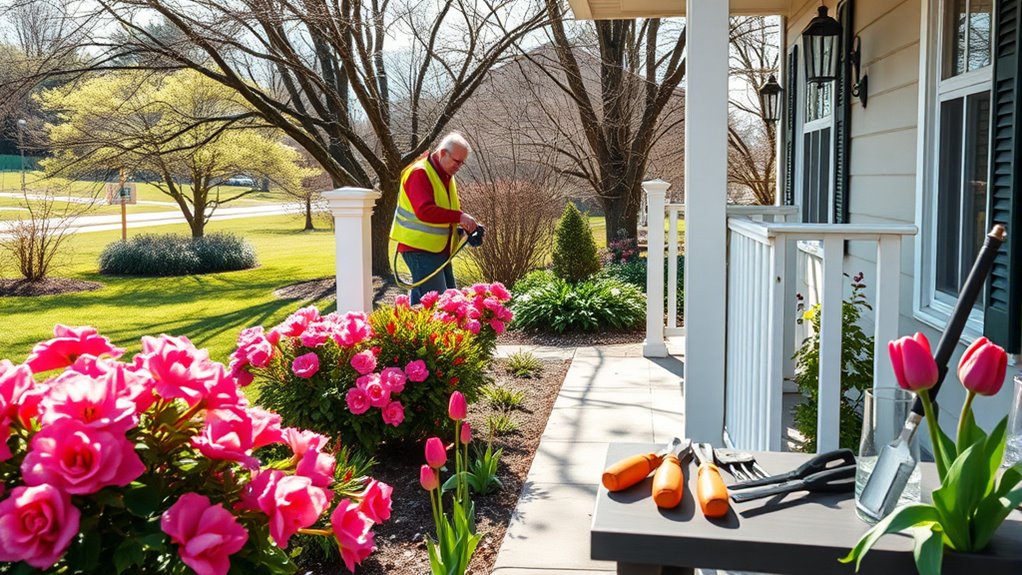
Spring is the perfect time to check your home’s ventilation and give the exterior a good cleaning. Ensuring proper airflow and clearing debris keeps your home comfortable and safe. Regular maintenance tasks like inspecting filters and vents can also improve overall air quality for senior homes. Taking these simple steps now can prevent bigger problems later in the season. Additionally, evaluating your waterproofing and sealing can help protect your home from potential weather-related damage as seasons change. Incorporating home decor and design elements such as weather-resistant finishes can further enhance your home’s durability and appearance.
Seasonal Ventilation Checks
Have you checked your home’s ventilation systems lately? Performing seasonal checks helps maintain good indoor air quality and ideal airflow.
Start by inspecting and cleaning air vents, exhaust fans, and outdoor air intakes to prevent blockages and dust buildup.
Regularly test and replace batteries in carbon monoxide detectors and smoke alarms to ensure ventilation safety.
Don’t forget to examine attic and basement areas for mold or moisture issues, which can affect humidity control and indoor air quality.
Service exhaust fans in kitchens and bathrooms to keep them operating efficiently, removing excess humidity and pollutants.
- Clean window and door screens for proper airflow
- Check for debris around vents and air intakes
- Address any signs of excess moisture or mold
Exterior Cleaning Tasks
Maintaining your home’s exterior is a key part of spring home care, especially after the winter months. Start with exterior cleaning to remove dirt, mold, and algae from outdoor surfaces like siding and windows using pressure washing.
Clear gutters and downspouts of debris such as leaves and nests to ensure proper water drainage, preventing water damage and pest issues. Inspect your roof for debris and damage, and clean it to avoid potential leaks.
Check for cracks in windows and doors, then seal them to improve energy efficiency and indoor comfort. Regular sealing helps prevent drafts and further deterioration.
Additionally, ensure safety by testing outdoor smoke and carbon monoxide detectors, replacing batteries as needed. Proper exterior cleaning preserves your home’s integrity and safety year-round.
Summer and Year-Round Tasks
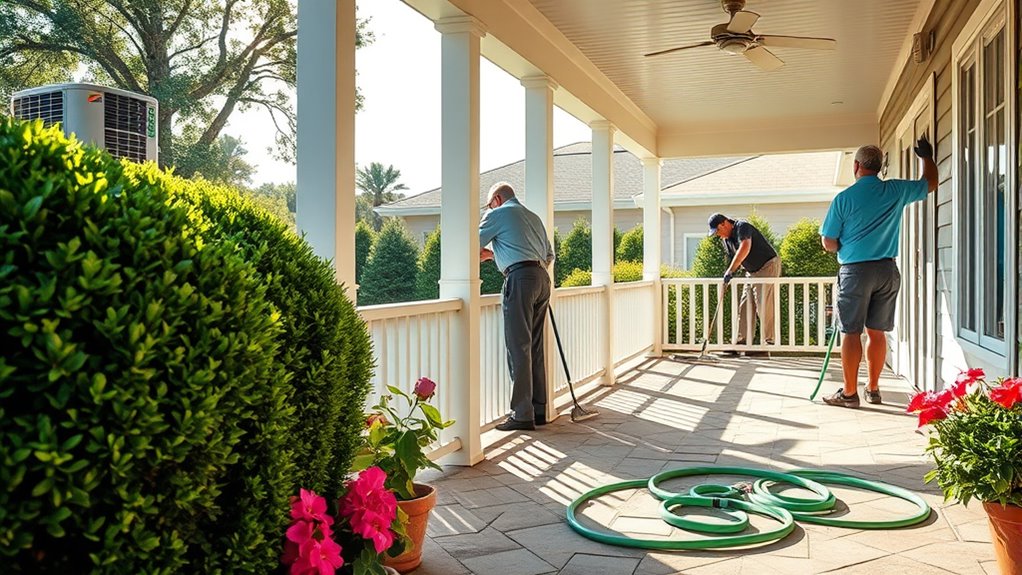
To keep your home safe and comfortable year-round, it’s essential to stay on top of summer and ongoing maintenance tasks. Regular lawn mowing and edging prevent overgrown grass that can hide trip hazards and pests.
Regular lawn mowing and edging keep your yard safe and tidy year-round.
Gutter cleaning ensures proper drainage and reduces water damage risks. Monitoring for pests like termites and rodents protects your home’s structure and indoor air quality.
Seasonal inspections of your roof and outdoor plumbing help catch issues early. Additionally, maintaining outdoor furniture and deck surfaces prevents deterioration and ensures safe outdoor spaces.
By prioritizing these tasks, you improve outdoor safety and preserve your home’s integrity, making it a secure and inviting environment for everyone.
- Inspect and repair outdoor furniture and decks
- Clean gutters and drains regularly
- Watch for pests continuously
Key Maintenance Principles and Planning
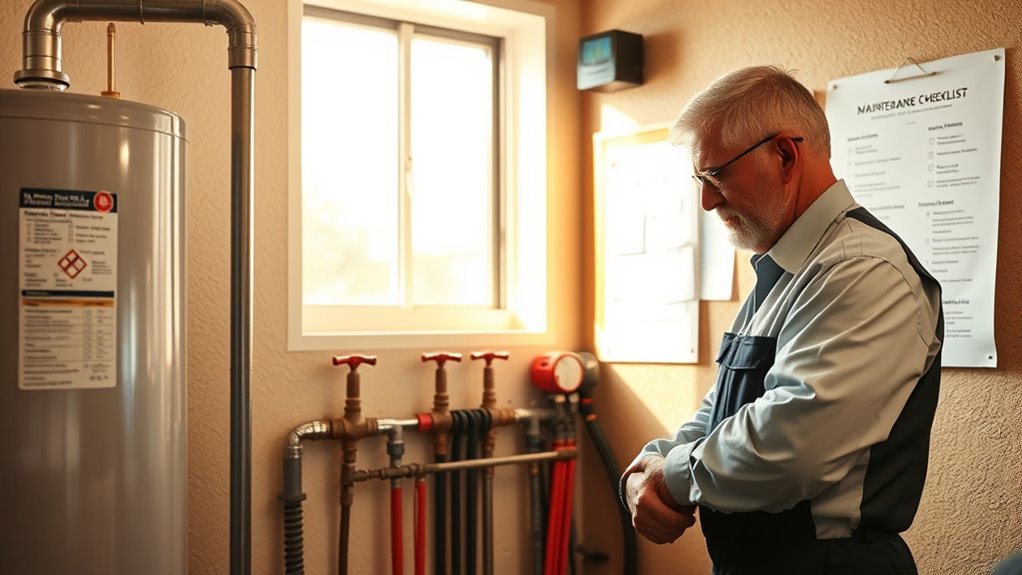
Developing a structured approach to home maintenance guarantees that tasks are manageable and effective over time. You should establish a routine schedule for seasonal inspections and preventative measures, like sealing cracks and testing safety devices. Regular safety assessments and safety checklists help keep your home secure and identify issues early. Prioritizing safety protocols and safety modifications creates a safer environment tailored to your needs. Planning ahead ensures safety protocols stay current as requirements evolve. Use the table below to organize your maintenance tasks:
| Frequency | Tasks |
|---|---|
| Monthly | Check safety devices, review safety checklists |
| Seasonal | Conduct seasonal inspections, update safety modifications |
| Annual | Engage professional inspectors for comprehensive safety assessments |
Exterior and Structural Care
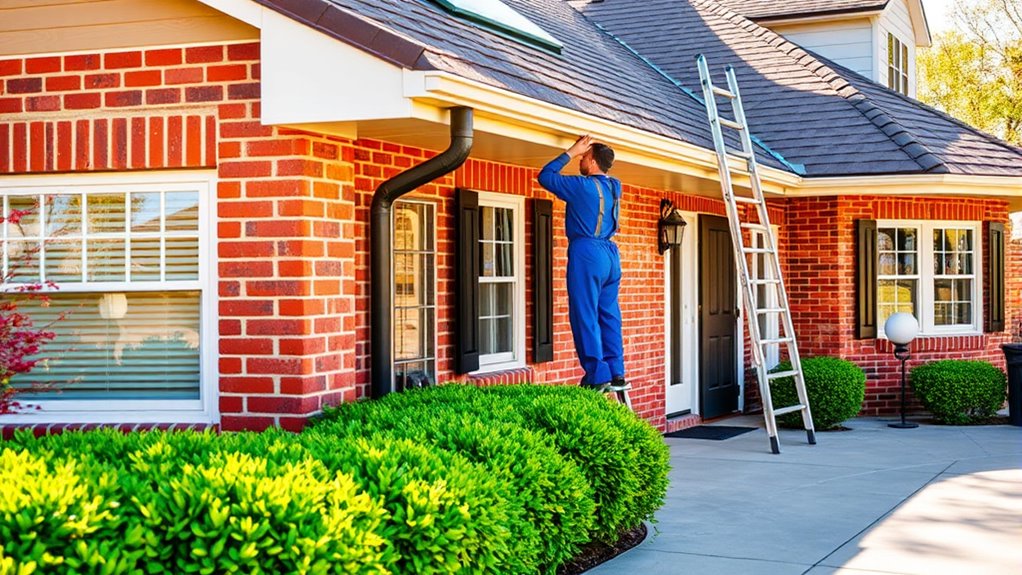
Regular exterior and structural care is essential for protecting your home from the elements and preventing costly damage. Proper exterior maintenance guarantees your home remains weatherproofed and structurally sound.
Regular exterior upkeep safeguards your home and prevents costly damage from the elements.
Start by inspecting roof shingles biannually for missing or damaged pieces to prevent leaks and deterioration. Keep gutters and downspouts clear of debris to maintain proper water drainage and avoid foundation cracks.
Examine siding for damage and reapply caulking around windows and doors annually to enhance weatherproofing. Additionally, regularly evaluate driveways and walkways for cracks or uneven surfaces, repairing them promptly to reduce fall hazards.
Always check your foundation for cracks or settling during seasonal inspections, addressing issues early to preserve your home’s structural integrity and avoid expensive damage repair down the line.
- Inspect roof shingles and leaks regularly
- Keep gutters and downspouts clear
- Reapply caulking around windows and doors
Interior Systems and Safety Equipment
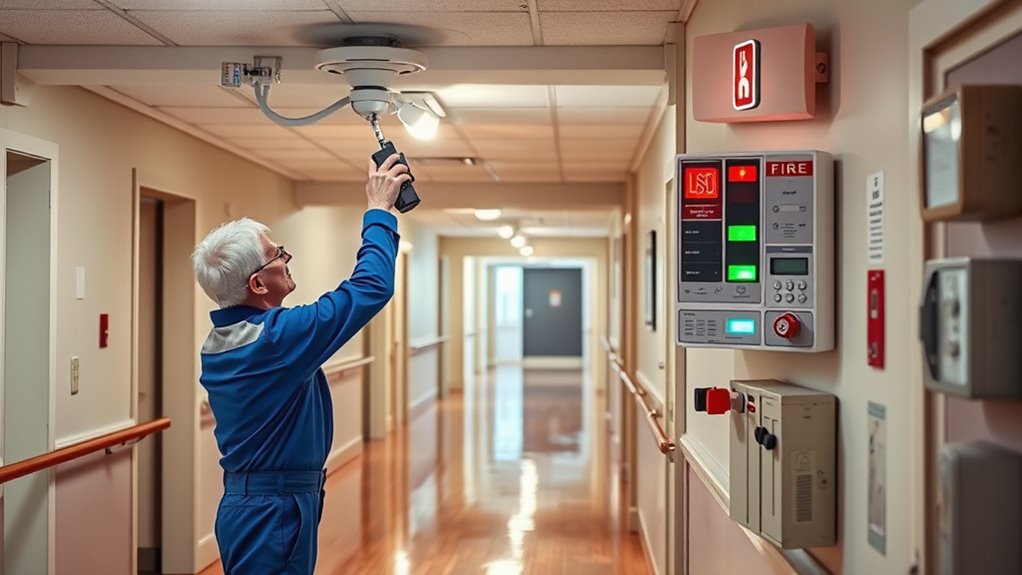
Maintaining your home’s interior systems and safety equipment is crucial for ensuring a safe and comfortable environment. Regularly test smoke alarms and carbon monoxide detectors monthly, and replace their alarm batteries at least once a year to keep them reliable.
Inspect electrical outlets, cords, and GFCI switches to spot potential fire or shock hazards. Confirm safety equipment like fire extinguishers are accessible, with gauges in the green zone and expiration dates checked annually.
Check and calibrate thermostats periodically to maintain consistent climate control and energy efficiency. Keeping these systems in top condition helps prevent accidents and ensures prompt response in emergencies.
Proper maintenance of safety equipment and electrical components is essential for the safety and well-being of everyone in your senior home.
Creating a Routine Maintenance Schedule
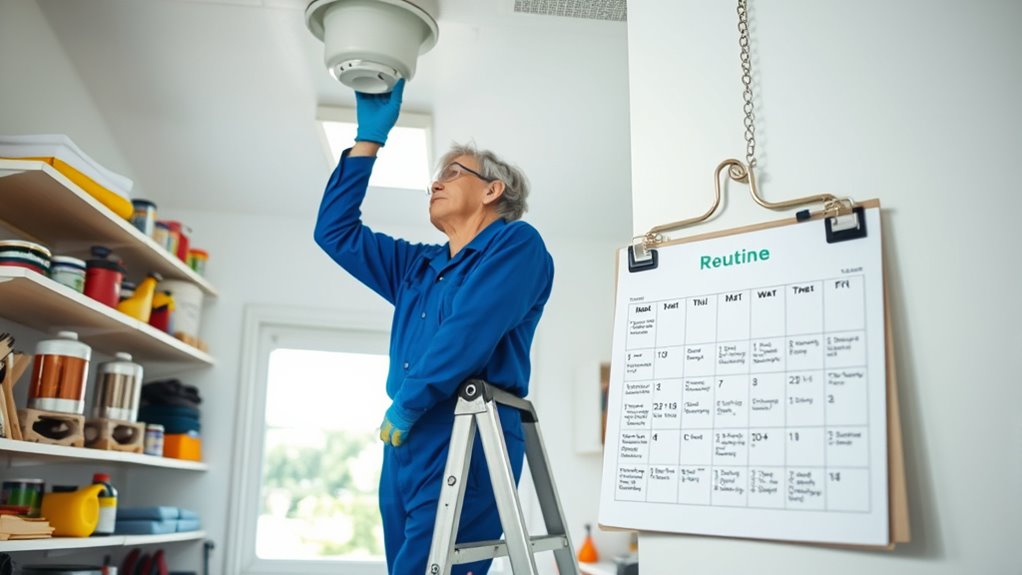
Creating a routine maintenance schedule is essential for keeping your home safe and well-functioning. By establishing a clear schedule, you ensure regular inspections and preventive tasks are never overlooked.
Consistency is key—using digital reminders or calendars helps you stay on track with seasonal chores like gutter cleaning in fall or HVAC servicing in spring. A detailed checklist can guide you through safety inspections, such as testing smoke detectors and checking for water leaks.
Prioritizing preventive tasks, like sealing cracks or replacing batteries, reduces the risk of accidents and costly repairs. Assigning specific days for home checks creates structure and promotes ongoing safety awareness.
With a well-planned schedule, you’ll maintain a safer, more reliable home environment effortlessly.
Frequently Asked Questions
What Are Examples of Maintenance Tasks?
You’re asking about maintenance tasks, and there are many vital ones to keep a home safe and functional. You should regularly inspect and replace HVAC filters, test smoke and carbon monoxide detectors monthly, and secure loose rugs, handrails, and cords to prevent falls.
Additionally, cleaning gutters, inspecting the roof, and winterizing outdoor plumbing are essential. These tasks guarantee safety, comfort, and efficiency in your senior home.
What Are the Duties of Home Maintenance?
Home maintenance involves keeping your space safe, functional, and comfortable. You inspect systems like electrical wiring, plumbing, and HVAC regularly to catch issues early. Tasks include cleaning gutters, replacing filters, and checking for leaks.
You also test safety devices like smoke and carbon monoxide detectors to guarantee they work properly. Seasonal chores like winterizing pipes and inspecting roofs help protect your home from weather damage, ensuring safety and longevity.
What Is the Maintenance Checklist?
Imagine a safe, cozy space where everything runs smoothly—your maintenance checklist makes that happen. It includes checking smoke and CO detectors monthly, inspecting outdoor walkways, gutters, and roofing, and testing electrical and plumbing systems.
Seasonal tasks like cleaning appliances and winterizing guarantee safety year-round. By staying proactive with these routines, you catch issues early, creating a secure environment where seniors feel comfortable and cared for every day.
What Is Regular Maintenance on a Home?
Regular maintenance on a home means performing routine checks and repairs to keep everything running smoothly. You inspect systems like heating, plumbing, and electricals regularly, ensuring safety devices such as smoke detectors work properly.
Seasonal tasks like cleaning gutters or inspecting the roof help prevent bigger problems later. Staying on top of these tasks saves you money, keeps your home safe, and maintains its value over time.
Conclusion
By staying on top of these maintenance tasks, you’ll keep your senior home a safe haven, much like the watchful eyes of Argus. Regular checks and thoughtful planning guarantee peace of mind, so you can focus on what truly matters—cherishing moments with loved ones. Remember, a well-maintained home isn’t just shelter; it’s your fortress, standing strong through seasons, just like the timeless resilience of a trusted hero.
